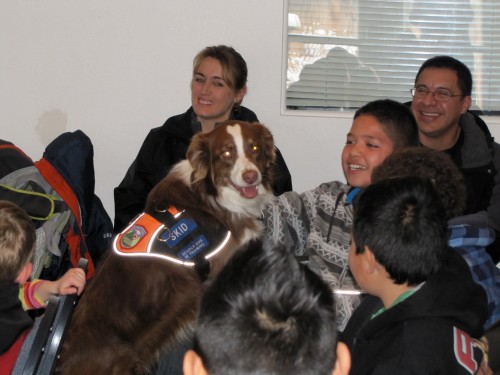by Treloar Bower, Curator of Education

Monte the Service Dog makes a new friend
Surprise, surprise, no pooper-scoopers needed around here last week! We celebrated Poudre School District’s Spring Break with a series of canine guest presenters, and every one of the dogs was very well behaved: not a single indoor lift of the leg in the bunch.
Actually, all of the dogs are highly trained working dogs, no couch-potato pooches in the bunch. They brought with them knowledgeable humans who shared stories of the jobs these dogs do, helping people. If you missed them, come in the week of March 30 – April 2 when all of our guests return during Thompson School District’s Spring Break.
The common theme among all the canines (Shadow the Arson Dog, Monte the Service Dog, K9 Officer Ace, and Skid the Search and Rescue Dog) is DRIVE. Each dog is driven to receive rewards for performing their trained tasks. For some of the dogs, like Shadow the Arson Dog, their reward is food. The only time Shadow is fed is when he successfully identifies accelerants. That means Firefighter Mike Manzo, Shadow’s handler, has to practice with Shadow about five times per day with actual accelerants so that Shadow can eat – directly from Firefighter Manzo’s hand, in order to build trust. For others, like Skid and Ace, the reward is a toy. Skid clearly lives for his tug-of-war rope, while Officer Ace has a heavy-weight, fabric chew toy that “hides” in his handler Officer Rob Knab’s back packet.
Each of the dogs is incredibly focused as well. For example, Monte the Service Dog must ignore all distractions (food, happy children, squirrels) to be safe for his human, Rich Dixon, to handle. For example, if Monte was tethered to Rich’s wheelchair and became interested in chasing the neighbor’s cat, he could pull Rich’s chair over, a very dangerous turn of events for Rich, no pun intended. Officer Ace watched his handler so carefully that, even when in a “stay”, if a suspect were to attack one of the police officers Ace would immediately leap into action and bite the suspect without a command!
Here are a few stories about our special guests:
Shadow the Arson Dog can detect 96 known accelerants with his nose. He goes to over 100 fire scenes every year to determine if accelerants were used by arsonists. Although he wasn’t trained to do this, he also once rescued a small dog hiding under a desk after a burglar had set fire to the building in which the dog was hiding.

Shadow the Arson Dog demonstrates his amazing nose
Monte the Service Dog can hear a pencil drop, even in another room, and retrieve it for Rich. If the pencil rolls under a desk, between electric cords, Monte can still get it without disturbing any cords (because, of course, if he tried to move a cord with his mouth, that could be very bad for him!). Monte is trained to perform up to 70 tasks for his mobility-limited companion Rich. Many service dogs are the sole reason their handlers can live independent lives, and have their own homes and jobs.

Monte the Service Dog loves to have his tummy rubbed
The Fort Collins PD does not use German Shepherds because of the risk of hip dysplasia in that breed. Instead, the corps of 4 canine officers includes a Belgian Malinois, a Dutch Shepherd, and one that is German Shepherd and Belgian Malinois mix. All of the dogs are super social. When they “attack” a suspect, they are actually having fun. As the police officers said, watch the dogs’ wagging tails and you’ll know the truth – these dogs are playing!

Officer Ace the Police Dog is having fun, but is the "suspect"?
Skid the Search and Rescue Dog is still working on his certification. So far, he has had 250 search and rescue “tests” – and he has located his lost hiker EVERY TIME. He and his owner, Jill Reynolds, are volunteers and put in many hours of training to do this. Jill selected Skid as an 8-week-old puppy to do this with her, but the way I heard the story is that the little fluff-ball Australian Shepherd may have picked her, jumping into her lap.

Skid the Search and Rescue Dog is working the crowd
Do we think dogs are amazing? Yeah. We really do.
(If you’d like to see more photos from our Dog-Gone Fun Spring Break, go to our Facebook page and check out the Photos section.)




























You must be logged in to post a comment.